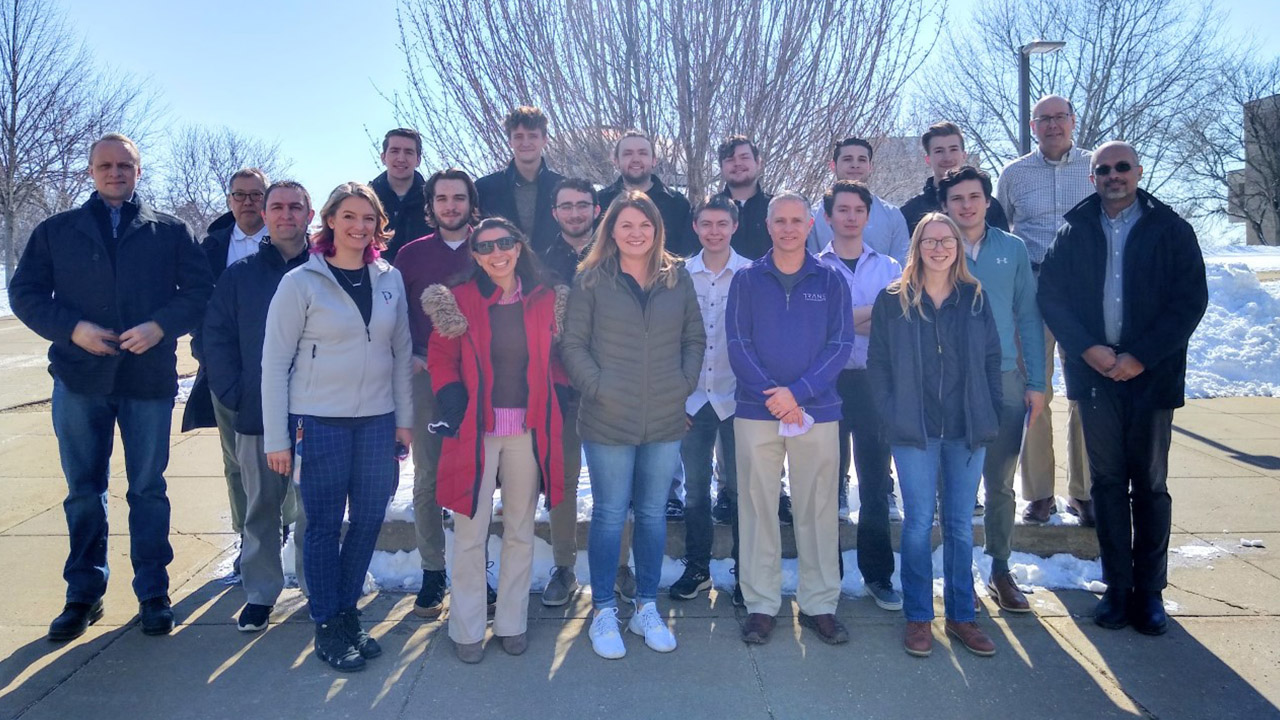
A dozen University of Wisconsin-Platteville students recently competed against each other, while helping local Platteville businesses reduce their carbon footprint and save money, as part of Trane Technologies’ inaugural Carbon Reduction Energy Blitz Challenge at UW-Platteville.
The week-and-a-half-long challenge partnered four teams of three UW-Platteville students with a faculty mentor and a mentor from Trane. Students worked with a Platteville business to identify ways it can reduce its carbon footprint, exploring all areas from energy use to waste to habits and culture. Participating businesses included Los Amigos, Barbershop Rock, Driftless Market and The Mining and Rollo Jamison Museums.
“We wanted suggestions to be high impact but also high ease of implementation,” said Dr. Jessica Fick, assistant dean for special projects in the College of Engineering, Mathematics and Science. “The suggestions have to be relatively inexpensive and have a short investment time so that they can get done.”
At the end of the challenge, students presented their findings to a panel of three judges, who selected the winning team based on the impact the solutions have at reducing carbon waste, the feasibility of the recommendations and the quality of work and presentation.
Michael Luoma, Hailie Ferrier and Spencer Butterfield – the group of students working with The Mining and Rollo Jamison Museums – took home the first-place award of $3,000 in tuition gifts, sponsored by Trane Technologies.
The challenge was a part of Trane Technologies’ commitment to sustainability initiatives. Having done similar challenges locally with their own employees, they approached UW-Platteville about the challenge opportunity after learning about the university’s similar initiatives and strategic goals surrounding sustainability.
“Trane Technologies’ 2030 Sustainability Commitments are multifaceted,” said Nao Tsumagari, from Trane Technologies. “It includes the goal to reduce greenhouse gas emission from buildings in the world by one gigaton. We have also committed to develop partnerships to foster STEM and help communities uplift the long-term well-being of their citizens in our communities through collaboration and volunteerism. When we learned about this program, we found the perfect alignment to our strategy, and decided to provide a full support to make it successful.”
The challenge gave students the opportunity to apply concepts from the classroom in the field. The four teams gained experience interviewing business owners and reviewing business processes. The suggestions students made were varied but included addressing heat loss and the efficiency of windows and doors, upgrading appliances, exploring opportunities to compost and upcycle and more.
“This project is so exciting, because the work students are doing is the exact type of work they could be doing in the future,” said Dr. Bryce Cox, assistant professor of mechanical engineering and a faculty mentor to the student team working with Barbershop Rock, which won second place. “During my time in industry, I have worked several commercial projects doing the same calculations and having the same conversations with building owners as these students are doing. Several cities across the country are starting to require benchmarking of the energy performance of existing buildings, which is the very work these students are doing. There is great need in industry for students to be prepared to do this type of work. I am really impressed with the student group I worked with. What really stood out to me is the effort and creativity they have put into making their solutions feasible, making many recommendations that would be easy for the building owner to implement.”
The Mining and Rollo Jamison Museums presented a unique challenge to the winning student team, as it is a designated site on the State Register of Historic Places, which limited modifications that could be proposed. The students made it a top priority to preserve the historic charm of the building, recommending carbon reduction options that don’t break the historic preservation code or alter the exterior of the building.
“The Trane Energy Blitz was a great opportunity to experience building energy efficiency in a real-world setting, not only a classroom,” said Luoma, a junior mechanical engineering major from La Crescent, Minnesota. “While the short turnaround time limited the scope of the project, we were able to gain valuable experience conducting the initial steps of an energy audit and suggest feasible solutions that benefit the businesses we studied.
Ferrier, a freshman double majoring in sustainability and renewable energy systems and mechanical engineering, from Kaukauna, Wisconsin, agreed, adding, “Though the time span of the competition was short, I was able to learn a lot, especially about carbon footprints and some of the history of the buildings in Platteville. I enjoyed working with everyone involved including Mr. Erik Flesch, from the Mining and Rollo Jamison Museums; Dr. Zolper, from UW-Platteville; and my teammates.”